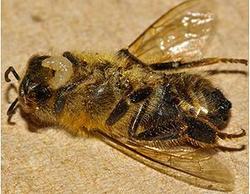Fly Parasite in Honey Bees Could Explain Colony Collapse Disorder
SAN FRANCISCO, California, January 10, 2012 (ENS) – Honey bees can be invaded by a fly parasite that causes them to abandon their hives and die after a period of disoriented, “zombie-like” behavior, according to a new study by San Francisco State University researchers.
The phenomenon, first observed on the San Francisco State campus, may lead to better understanding of colony collapse disorder, the researchers say. This mysterious ailment has caused honey bee colony losses across the United States since it was discovered in 2006.
 |
San Francisco State biology professor John Hafernik (Photo courtesy SF State) |
San Francisco State biology professor John Hafernik, whose reseach team discovered the fly parasite in bees, did not set out to study the parasitized bees. In 2008, he was just looking for some insects to feed the praying mantis that he had brought back to the university after a field trip.
He scrounged the bees from underneath the light fixtures outside the biology building.
“But being an absent-minded professor,” Hafernik joked, “I left them in a vial on my desk and forgot about them. Then the next time I looked at the vial, there were all these fly pupae surrounding the bees.”
The fly, Apocephalus borealis, deposits its eggs in a bee’s abdomen. Usually about seven days after the bee dies, fly larvae push their way into the world from between the bee’s head and thorax.
After being parasitized by the fly, the bees that survive abandon their hives to congregate near lights.
“When we observed the bees for some time – the ones that were alive – we found that they walked around in circles, often with no sense of direction,” said Andrew Core, an San Francisco State graduate student from Hafernik’s lab who is the lead author on the study.
The San Francisco State team surveyed local bee populations and found evidence of the parasitic fly in 77 percent of the hives they sampled in the Bay Area, as well as some hives in California’s agricultural Central Valley and in South Dakota.
For his presentation of the bee research, Core won first place at the 2011 California State University Research Competition and the Geraldine K. Lindsay Award for excellence in the natural sciences at the annual meeting of the Pacific Division of the American Association for the Advancement of Science.
Bees usually just sit in one place, sometimes curling up before they die, said Core. But the parasitized bees that were still alive were unable to stand up on their legs. “They kept stretching them out and then falling over,” he said. “It really painted a picture of something like a zombie.”
 (Photo courtesy SF State) (Photo courtesy SF State) |
Fly larvae emerge from a bee after flies invaded the bee’s abdomen several days earlier. (Photo courtesy |
Bees that left the hives at night were more likely to bear the parasite than those who foraged during the day, the researchers found.
Genetic tests of parasitized hives showed that both bees and flies were often infected with deformed wing virus and a fungus called Nosema ceranae.
Some researchers have pointed to the virus and fungus as potential culprits in colony collapse disorder. It may be time to consider how the fly parasite fits into the picture, Hafernik said.
The infected bees may be leaving the hive of their own accord, or they may give off a chemical signal that provokes their hive mates to throw them out, he said.
“A lot of touching and tasting goes on in a hive,” Hafernik said, “and it’s certainly possible that their co-workers are finding them and can tell that there’s something wrong with them.”
Genetic analysis of the parasites confirmed that they are the same flies that have been infecting bumblebees, raising the possibility that the fly is an emerging and potentially costly new threat to honey bees.
The possibility that this is an emerging parasite “underlines the danger that could threaten honey bee colonies throughout North America, especially given the number of states that commercial hives cross and are deployed in,” Hafernik and colleagues write in the January 3 issue of the journal “PLoS ONE.”
“We don’t know the best way to stop parasitization, because one of the big things we’re missing is where the flies are parasitizing the bees,” Hafernik explained. “We assume it’s while the bees are out foraging, because we don’t see the flies hanging around the bee hives. But it’s still a bit of a black hole in terms of where it’s actually happening.”
The scientists will deploy tools, including tiny radio tags to video monitoring, to help them answer these questions and discover ways to protect the hives.
“Honey bees are among the best-studied insects in the world,” Hafernik observed. “So at one level, we would expect that if this has been a long-term parasite of honey bees, we would have noticed.”
Copyright Environment News Service (ENS) 2012. All rights reserved.
© 2012, Environment News Service. All rights reserved. Content may be quoted only with proper attribution and a direct link to the original article. Full reproduction is prohibited.
